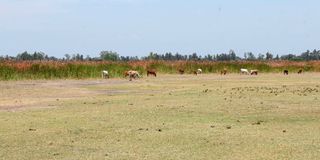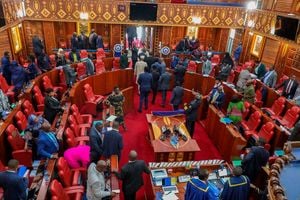The dying glory of Ondago swamp

Ondago swamp in Rachuonyo North Sub-county on February 7, 2023. The swamp is among wetlands in Homa Bay that are under threat due to environmental degradation.
What you need to know:
- During the World Wetland Day earlier this month, different players came together to make a commitment to protect Ondago swamp and other wetlands that are under threat in Homa Bay County. This was in tandem with this year’s theme, “Wetlands Restoration”.
- Part of the plans to restore Ondago is to do pegging to mark boundaries and keep off people who may encroach the area.
There were times when flamingos would fly for more than 150 kilometres from Nakuru to Homa Bay County to seek refuge when their habitat in the Rift Valley was under threat.
But this migration no longer happens. Lately, the flamingoes’ second home in Nyanza is also under threat due to human-induced environmental degradation.
The birds could fly from Lake Nakuru and Lake Bogoria to a little known wetland in Rachuonyo North called the Ondago swamp.
Local and foreign tourists would throng the wetland to witness the migration that formed a pink carpet on the water surface to cover the swamps' usual dark colour.
Until recently, Ondago swamp was not under any form of threat as it had an environment that was a sanctuary to different animals.
Unlike other water bodies which suffer from pollution, the marsh has no industry established within its boundaries nor are there streams that let in toxic water into it. This ensured the population of flamingos increased as they found plenty of food and no predators attacking them.
Ondago swamp is classified as a gazetted national bird sanctuary because of the different bird species it used to host.
According to the National Environment Management Authority (Nema), the swamp was gazetted in 1997 when birds came together on their migratory journey to different places across East Africa.
A textbook description paints the swamp as a lush green wetland covered with reeds and other green vegetation.
But in reality, Ondago swamp is currently covered with dry reeds, which are growing from dry soil that is not suitable for flamingos.
Some parts of the marshland, which had plenty of water that animals could resort to when seasonal rivers dried up, are now waterless, with the ground surface cracking from the hot sun.
Mr Eliakim Abeka, an 85-year-old resident of Central Karachuonyo, says he witnessed when the swamp was full of birds and every plant within the area was green.
"We used to fish from the farm. Apart from the birds, the swamp was also a habitat for hippos and other aquatic animals," he says.
Mr Abeka affirms that even during dry seasons, the swamp retained its glory and did not lose as much water as it does today.
He recalls how the soil around it would remain wet as residents caught catfish that were stuck in mud.
Mr Abeka blames families around the marshland for being behind its death.
Some people started harvesting sand from the area as they reduced the space that animals use to feed.
A stream that channels water from the swamp to Lake Victoria was also blocked and can no longer eliminate excess water from the swamp.
"The swamp has silt that makes runoff to homes. Its outlet was blocked and can no longer drain excess water when it rains.”
County Nema Director Josiah Nyandoro says residents around the swamp are to blame for the negative ecological changes at Ondago that have drained its water.
He notes that part of the swamp has been encroached and some of the activities by families living at its edge are to blame for its slow death.
According to the agency, the swamp should be 45 hectares but it is now about half the size, most of it dry with the remaining part taken up for human settlement.
“This is based on the findings of the defunct South Nyanza county council,” he says.
Destruction of Ondago swamp has been attributed as one of the factors contributing to the suffering of residents of some parts of Karachuonyo who have to migrate from their homes annually when it floods.
Mr Nyandoro says wetlands control floods and Ondago can help families that have been decrying perennial flooding in their homes. “Swamps purify water and preserve flora and fauna. They also contribute to micro climate sustainability and maintain the water table,” he says.
At Ondago, families have burned vegetation, claiming it harbours dangerous animals. This in turn has caused the swamp to shrink in size.
There are, however, activities that can be done in the area without hurting the environment and without being questioned by conservationists.
They include sustainable harvesting of trees, harvesting of plants for medicinal purposes as well as subsistence hunting. Mr Nyandoro adds that fishing can also be done in swamps.
“We discourage and are responsible for regulating activities like construction and waste disposal at the swamp,” he says.
During the World Wetland Day earlier this month, different players came together to make a commitment to protect Ondago swamp and other wetlands that are under threat in Homa Bay County. This was in tandem with this year’s theme, “Wetlands Restoration”.
Part of the plans to restore Ondago is to do pegging to mark boundaries and keep off people who may encroach the area.
Mr Nyandoro says the exercise will be done by the agency in collaboration with the county government of Homa Bay and the National Water Harvesting Authority.
Mr Willis Omullo, an environmentalist in Homa Bay, points out that wetland restoration is important as it contributes to biodiversity conservation. “We need to encourage our people to focus on protecting such places for economic livelihood. Conservation of wetlands is also crucial in climate change mitigation measures and adaptation.”





